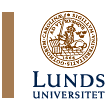

|
Panel No. 38Panel Title: The Tamil panelConvenor: Professor Peter
Schalk, Dept of Theology, History of Religions, Uppsala University,
Sweden Wednesday 7 July, 13–17 Panel Abstract: A panel that combines linguistic, historical, religious, social, and political studies of the Tamil speaking area in India and Lanka.
Papers accepted for presentation in the panel:Paper Giver 1: Gabriella Eichinger Ferro-Luzzi, Rome, Italy Paper Title 1: A Tamil Writer's View of Time Paper Abstract: The great Tamil writer L.S. Ramamirtham uses his literary creations to express his religious-philosophical ideas. Among these time occupies a conspicuous place. He deals with both universally recognised aspects of time and with more culture-specific ones. The former include the arrow of time and the speed of time, the latter the right personal moment. He acknowledges the arrow of time and the regular divisions of time but is particularly fascinated about time felt to flow at irregular speed according to ones state of mind. His greatest interest lies in the right personal moment. While agreeing with Ía+kara on the illusionary nature of time he paradoxically believes in the reality of the moment lying outside time. In this right personal moment his mystic visions of the goddess occur. His various views of time are illustrated through beautiful and suggestive similes and metaphors. Paper Giver 2: Dagmar Hellmann-Rajanayagam, Centre for Social Science Research, University of Erlangen-Nürnberg Paper Title 2: Dynasties and female political leaders in Asia – Does Jayalalitha conform to any model? Paper Abstract: Since a few years, female politicians have become prominent in India if not at the top of the state, at least at the second level: at the last count, there were five female chief ministers. Generally it is assumed that women succeed in politics because of a dynastic background, i.e. belonging to a political family and having male relatives in politics. The paper will investigate these assumptions for the case of J. Jayalalitha in Tamilnadu who has won the Assembly elections twice. She does not, however, come from a political family, nor did she have male relatives in politics. On the contrary: she was merely the mistress of a now dead chief minister and could wrest the chairmanship of his party and the government from his legitimate widow. The paper will discuss how and why this happened and what it means for politics and female politicians in India. Paper Giver 3: C.S. Mohanavelu, Presidency College, Chennai, India Paper Title 3: Lifestyle of the Madrasis, during 18th Century, as Reported by the German Missionary, Schultze: A Few Aspects Paper Abstract: German Studies in
Tamil History is a fathomless fascination. From 1706, hundreds of
Germans were sent to Tamilnadu as Royal Danish missionaries for
the spread of the Gospel. The Danish King ordered them to mind in
the east Indies nothing besides the Holy Doctrine. But almost all
those Germans showed remarkable interest for the many faceted indigenous
Tamil society. Unable to resist their nascent temptation to know
more and more about the indigenous Tamil society, they recorded
in thousands of their diaries, all about their interactions with
and observations of the indigenous Tamil society. In fact, their
zeal for the spread of the Gospel, undoubtedly was overpowered by
their irresistible curiosity, which outweighed their very religious
mission, resulting in a spiritual paralysis. They were all wrongly
informed that the Tamils were barbarous; but soon after their arrival
here, they found good enough reasons to change this wrong notion,
when they found to their unbelievable surprise, a contrary well
civilised Tamil society. Full paper to be downloaded (as a pdf-file) Paper Giver 4: Paula Richman, Department of Religion, Oberlin College, Ohio, USA Paper Title 4: Is the Blame Gone? Sita, Ahalya, and Surpanakha in Modern Tamil Fiction Paper Abstract: This paper considers
how modern Tamil writers have reconceptualized female characters
and incidents from the Ramayana narrative. The paper examines the
Paper Giver 5: Peter Schalk, Dept. of Theology, University of Uppsala Paper Title 5: How Valli came to Katirkamam Paper Abstract: It is unclear when, how and why Valli from the early Tamil literature up to the Kantapuranam appears in Katirkamam (Kataragama) and there becomes the heroine of väddo, Sinhala Bauddhas and Tamil Caivas. This paper intents to highlight a neglected link. Paper Giver 6: Laure Singaravelou, Paris Paper Title 6: Event and Eventualization in Anthropology. A South Indian Case Paper Abstract: I would analyse the event which took place in southern Tamil Nadu on a Muslim shrine's site, a dargah: state's intervention in august 2001 at Erwadi-Dargah on Supreme Court's decision in order to destroy confinement institutions mushroomed for the last 25 years outside the dargah's walls. And how to understand links between this event and another one that anthropologist's fieldwork (myself in that case) and inquiry had contributed to build by narrating it: the "mental hostel"' institution as such whose genesis I tried to open out. Above all an accepted proposal would make possible the precious and unexpected interactions and meetings with more experienced and learned scholars. Paper Givers 7: V. Sudarsen and S. Sumathi, Dept. of Anthropology, University of Madras, Chennai, India Paper Title 7: Dominance and Masculinity: Dominant Castes and Dalits of Tamil Nadu Paper Abstract: Gender perspectives
include studies of masculinities as the latter have clear implications
for identities. This is true of the relationships between different
caste groups in India--- the relationships in the private and public
domains in terms of social violence, patriarchal values and cultural
co-option as well. The present paper attempts to bring out masculinity
as a value in asserting power dominance and the discourse used by
the local dominant community. This kind of assertion of masculinity
is seen manifesting dominance over dalitsin several parts of India.
Paper Giver 8: Torsten Tschacher Paper Title 8: How to die before dying? Sharia and Sufism in a 19th century Arabic-Tamil poem Paper Abstract: Islamic literature in Tamil has until now received scant regard by scholars of Tamil. In the few studies that have appeared, attention has mainly been paid to the way Islamic poets used Tamil to express Islamic concepts and adhered to poetical conventions, while the content of the poem itself is largely ignored. This paper aims at rectifying this situation by analysing the contents of a 19th century poem in Arabic-Tamil (Tamil written in Arabic script), the Hadya Malai by Imam al-Arus. Even though the poem appears to be mainly a work on proper behaviour, it is permeated by Sufi notions of the mystical path, which are brought out fully only when considering the poem as an integrated literary work rather than a mere assemblage of more or less interesting stanzas. Paper Giver 9: Indira Viswanathan Peterson, Middle East and Asian Languages and Cultures (MEALAC), Columbia University, New York, USA Paper Title 9: Eighteenth-century Madras through Indian Eyes: Cultural Performance, Urban Space, and Power in the Sanskrit text Sarvadevavilasa Paper Abstract: This paper critically examines the convergences and divergences between the perspectives offered in Sarvadevavilasa, a Sanskrit text, and the colonial archive, regarding the role of cultural performances in the construction of Madras city as a new type of urban space in the late eighteenth-century. Written around 1800 in the prose-poetic campu literary genre, SDV describes, in the form of a dialogue between two learned Brahmins, the activities of wealthy patrons of the arts and letters (Telugu and Tamil Dubashes, merchants) in Madras and its environs, especially in the context of the temples built or endowed by these patrons, who are historically identifiable individuals. Various kinds of public cultural performance -- pilgrimages, processions, worship at temples, temple festivals, dinner-parties and diversions, gatherings of Brahmin scholars, concerts of dance and music – form the main focus of SDV's descriptions It is argued that SDV is a novel work, reflecting the new personae and pre-occupations assumed by Indian elites in the physical and social environment of the colonial port city, structured by and around Indian and European mercantile interests. Unlike earlier Sanskrit works, SDV focuses on the acts of multiple patrons in an unitary urban space. A new sacred-secular geography is inscribed on the topography of the city by the movement of these patrons among temples and garden houses and by artistic performances at specific locations. This study is used to query the notions of 'tradition' and 'modernity' put forward in Milton Singer's work on Madras (When a Great Tradition Modernizes, 1971) and to amplify the findings in recent scholarship on the growth of Madras as an urban cultural centre (e.g., Lewandowski 1978, 1985, Mines 1994, Waghorne, 1999).
SASNET - Swedish South Asian Studies Network/Lund
University
|

